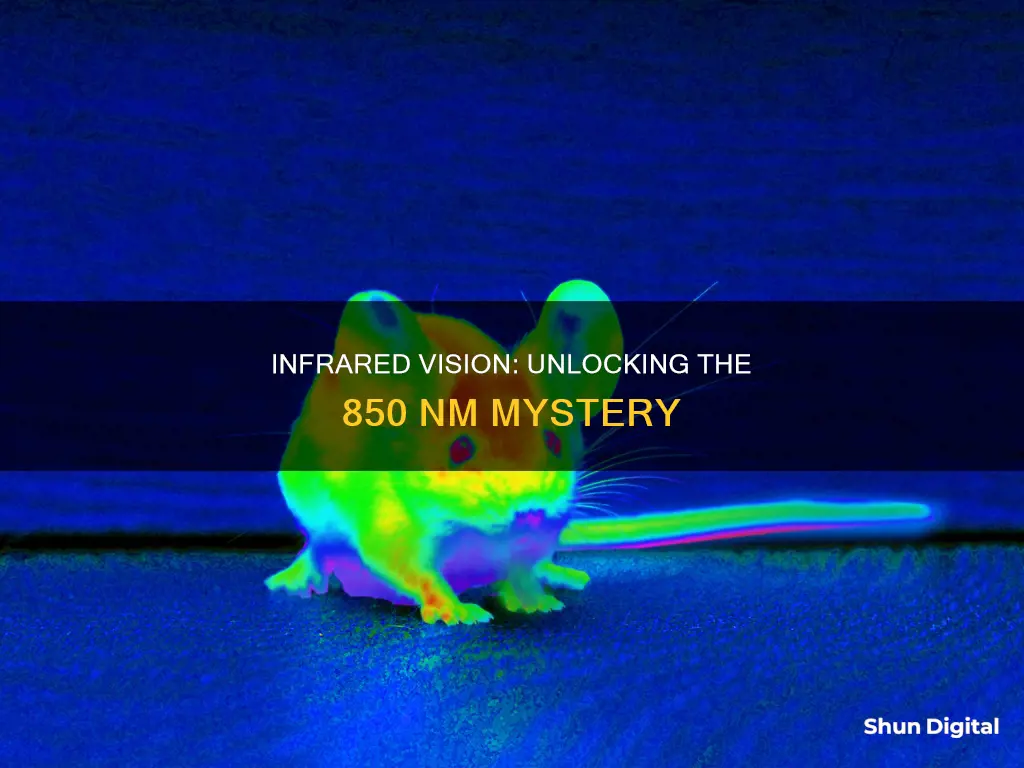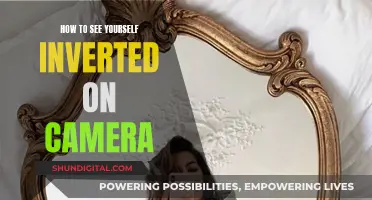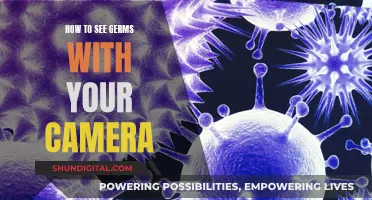
Infrared light with a wavelength of 850 nm is commonly used in CCTV cameras to improve their night vision capabilities. While this wavelength is invisible to the human eye, it produces a faint red glow when looking directly at the source. CCTV cameras are typically sensitive to this wavelength, which is why it is so widely used for infrared illumination.
What You'll Learn

850nm wavelength is hard to see with the naked eye but not impossible
The human eye typically responds to wavelengths from about 380 to 750 nanometres (nm). Outside of this range, our ability to see light falls away sharply.
Infra-Red (IR) light in the 850nm wavelength is hard to see with the naked eye but not impossible. If you are close to an IR LED source operating at 850nm and looking at it from the right angle, you may perceive a dull red glow. This is because 850nm is very close to being visible light, and the human eye can slightly perceive this frequency. However, 850nm IR is invisible to the human eye in terms of "light" illuminating other objects.
While 850nm IR light is difficult to see with the naked eye, it is very effective when used with CCTV cameras, which can be produced with a sensitivity to light in this spectrum. IR LEDs that operate at this wavelength are also relatively easy to produce. As such, 850nm IR light is commonly used for semi-covert illumination in CCTV images. While humans can only see a dull red glow around an IR LED lamp operating at 850nm, an IR-sensitive CCTV camera can produce a bright, clear monochrome image in total darkness using this wavelength of light.
The 940nm wavelength, on the other hand, is even more difficult to see with the naked eye. It is further from the visible spectrum, making it harder to detect the source of the light at night. However, the sensitivity of most security cameras falls off quickly from 850nm to 940nm. Therefore, to achieve the same image quality at 940nm, you would need to use twice the amount of IR power compared to using 850nm LED lamps.
Exploring Apple TV: Viewing Camera Feeds
You may want to see also

850nm is the standard for most applications, including CCTV
The human eye can typically see light in the range of 380nm to 700nm. Light above 700nm in the infrared spectrum is not visible to the human eye. However, shorter "near-infrared" wavelengths, from about 700nm to 900nm, can appear as a faint red glow when looking directly at a high-powered IR LED source.
IR light is used to enhance security camera performance at night or in low-light conditions. This is because most security cameras have sensors that are sensitive to IR wavelengths that are invisible to the human eye. While 850nm is commonly used, it is important to note that it is not suitable for all applications. For truly covert operations, 940nm IR light is recommended as it is completely invisible to the human eye, producing no source red glow. However, 940nm IR may have up to 50% less range than 850nm IR, and only a handful of cameras are sensitive to this wavelength.
When choosing between 850nm and 940nm IR illuminators, it is important to consider the specific requirements of the application. If covert surveillance is a priority, then 940nm may be the better option. However, if a longer range is required and slight visibility is not an issue, then 850nm is likely the better choice. Additionally, it is crucial to ensure that the chosen wavelength is compatible with the camera's specifications.
Understanding the Vibrating Camera Symbol on Your Apple Watch
You may want to see also

IR cameras are most sensitive to radiation at 850nm
Infrared (IR) cameras are most sensitive to radiation at 850nm. This is because 850nm is very close to the visible spectrum, which the human eye can perceive. While it is difficult to see 850nm with the naked eye, it is not impossible. IR cameras are able to easily produce sensitive images in this spectrum.
The 850nm range is particularly useful for CCTV cameras, which can be produced with a sensitivity to light in this spectrum. This makes it a good choice for semi-covert illumination of CCTV images. For example, an IR-sensitive CCTV camera can produce a clear image in total darkness with the help of an IR LED lamp operating at 850nm. However, the images produced are usually only in monochrome, as they are relying on light from one precise wavelength.
The 850nm range is also useful for night vision devices such as binoculars and goggles. The wavelength provides the best picture quality and has a slightly longer usable range compared to 940nm. 850nm is also less likely to create blurry images. However, one drawback of 850nm light sources is that they give off a visible red glow, which could be a problem in certain situations.
For more covert operations, 940nm is a better option as it is further from the visible spectrum and is much harder to see. However, the image quality and range are slightly lower, and more IR power is needed to compensate for the decreased sensitivity.
Can the FBI Spy on You Through Your Camera?
You may want to see also

850nm produces a faint red glow
Infrared light in the 850nm wavelength range is difficult to see with the naked eye, but not impossible. It appears as a faint red glow, which is more noticeable if you are closer to the source and looking at it from the right angle. This is because 850nm is close to the visible spectrum, with wavelengths of around 390 to 750nm perceivable to the human eye.
The faint red glow produced by 850nm light is more visible than that of 940nm light, which operates further from the visible spectrum. This makes 850nm a good choice for semi-covert illumination in CCTV cameras, as it is still visible to IR-sensitive cameras. However, the faint red glow can be a disadvantage in certain situations, such as when trying to remain hidden from humans or animals.
The human eye can slightly perceive the 850nm frequency, so an IR flashlight may exhibit a slight red glow. This could be a problem if you are trying to remain hidden, as the red glow could give away your location. For example, when observing badgers or coyotes, the red glow is unlikely to be an issue, but it may disturb more cautious wildlife.
For this reason, 940nm light sources are sometimes preferred for "stealth" applications, such as airsoft and security, as well as for tracking wildlife that may be scared by the red glow. However, it is important to note that 940nm light sources may still produce a small red glow, although it is significantly reduced compared to 850nm sources.
In summary, while 850nm light is difficult to see, it does produce a faint red glow that can be observed under certain conditions. This makes it a good choice for CCTV cameras but may be a disadvantage in situations where stealth is required.
Curved LG OLED TVs: Where's the Camera?
You may want to see also

850nm is semi-covert
Infrared light at 850nm is semi-covert because, while it is invisible to the human eye, it can produce a slight red glow. This makes it a good choice for semi-covert illumination when used with CCTV cameras. This wavelength is hard to see with the naked eye, but not impossible. If you are close to the source of the light and at the right angle, you may see a dull red glow around an infrared LED lamp operating at 850nm.
The human eye can perceive frequencies from around 390 to 750nm, and outside of this range, our ability to see light drops off sharply. 850nm is just outside of this range and is, therefore, difficult to see. However, it is still possible to detect a faint red glow, particularly at higher powers.
The 850nm range is very close to being visible light, and while the human eye can barely perceive this frequency, it can result in a slight red glow. This means that an infrared flashlight or torch operating at 850nm could give away your location. For this reason, 940nm torches are often used for "stealth" applications, such as airsoft and security, or for tracking cautious wildlife.
However, 850nm is still considered semi-covert because the red glow is not always noticeable. It is much less visible than the glow produced by 850nm sources, and in many cases, it will be negligible or invisible. The 850nm wavelength is also very effective when used with CCTV cameras, which can easily be produced with a sensitivity to light in this spectrum. It has a longer range than 940nm and is ideal for most security cameras.
Finding Your Roku TV's Camera and Microphone
You may want to see also
Frequently asked questions
It is a type of infrared light that is commonly used in CCTV cameras for night vision.
No, but it is not completely invisible to the naked eye. One may see a faint red glow from an 850 nm light source.
940 nm is further away from the visible spectrum, so it does not emit any glow, making it completely invisible. However, only a few cameras are sensitive to 940 nm, and its illumination range is shorter than 850 nm.
850 nm will give the best picture and has a longer usable range. Most security cameras are also sensitive to this wavelength.
The faint red glow from the light source may be a problem in certain situations, such as when trying to remain hidden.







